The salinity tolerance of pomegranate cultivars: Effects of salt stress on root and leaf mineral content
Published 2020-07-14
Keywords
- dry and fresh weigh,
- mineral composition,
- NaCl,
- salt stress
How to Cite
Abstract
In this study, the effect of irrigation water salinity on rooted cuttings of eight pomegranate cultivars namely ‘Malase Saveh’ (‘MSaveh’), ‘Malase Isfahan’ (‘MIsfahan’), ‘Robabe Ghermeze Shiraz’ (‘Robab’), ‘Gabrie Yazd’ (‘GYazd’), Gabrie Torshe Yazd’ (‘GTYazd’), ‘Zaghe Sefide Yazd’ (‘ZSYazd’), ‘Zaghe Torshe Yazd’ (‘ZTYazd’) and ‘Malase Torshe Pishva’ (‘MPishva’) was studied. Sodium chloride was added to irrigation water to get final concentrations of 3, 6, 9 and 12 dS/m. Leaf and root mineral content, leaf abscission and root characteristics were determined at the end of the experiment. The results showed that the salinity reduced significantly fresh and dry weight of root in all pomegranate cultivars. Water salinity up to 3 dS/m increased slightly roots fresh and dry weight of all cultivars and thereafter decreased. With increasing water salinity to 12 dS/m, accumulation of sodium and chloride both in roots and leaves increased, but nitrogen, phosphorus, magnesium and calcium contents decreased. The change of leaf potassium content was dependent to pomegranate cultivar. The lowest sodium and chloride accumulation in root was observed in ‘ZTYazd’, but ‘MPishva’ translocated the lowest sodium and chloride to leaf. The low ability of nitrogen absorption was found in ‘MSaveh’, whereas ‘MPishva’ maintained the highest leaf nitrogen under salt stress conditions. The most potassium content of root was observed in GTYazd’, while ‘ZSYazd’ and ‘GYazd’ translocated the highest potassium to leaves. Generally, the responses of pomegranate to absorption and translocation of elements to leaves under salinity conditions were completely dependent to cultivar. ‘MPishva’ and Yazd cultivars showed higher tolerance to salinity stress.






